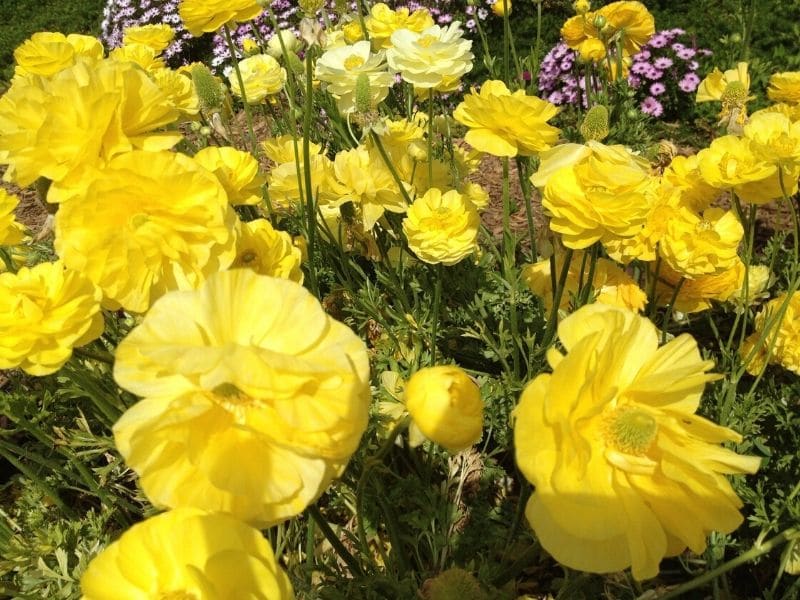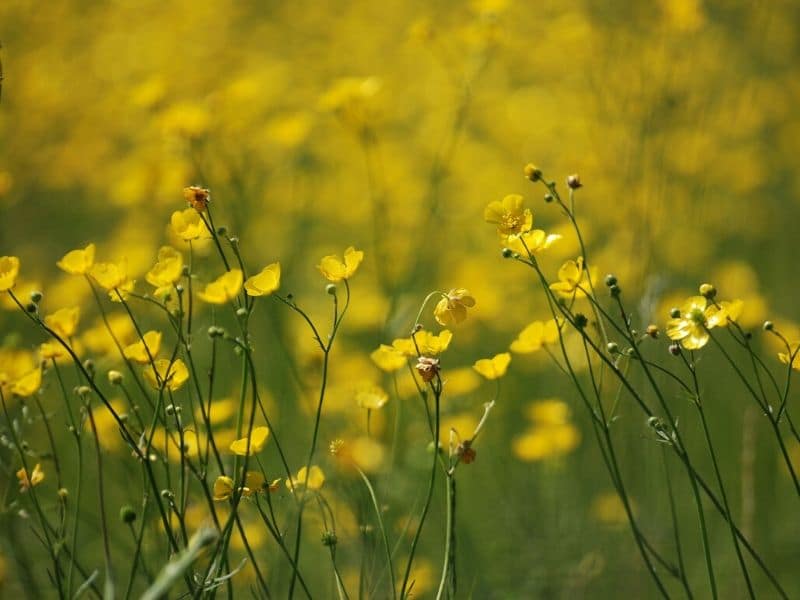The common name buttercup usually refers collectively to the entire Ranunculus genus in the Ranunculaceae family (otherwise known as the buttercup or crowfoot family). However, this article focuses more on the most popular type of buttercup among gardeners and flower enthusiasts – the Persian buttercups.
Ranunculus or buttercup flowers are cool-season perennial tubers characterized by their layers of paper-thin petals. Because of their dainty appeal, these blooms have always been a favorite in many wedding bouquets and floral arrangements. These blooms also frequent container gardens, beds and borders, as well as cutting gardens.
Read on our comprehensive guide below to learn everything about Ranunculus flowers, from facts to characteristics, uses, types, recommended varieties, and care and maintenance.
Ranunculus Flower Facts

Buttercup Flower: Name Origin
Buttercup is the most known common name of the entire Ranunculus genus in the Ranunculaceae family. The huge genus, which contains over 600 species, is native to the United States of America and Eurasia (1).
Other common names of ranunculus include Coyote’s eyes, water crowfoots, meadow buttercup, and spearworts.
While most flowers obtain their name based on their appearances or unique features, buttercup flowers have a different yet interesting name origin. The genus name ranunculus is based on two Latin words, rana and unculus, that collectively mean “little frogs.”
Native buttercup flowers grow abundantly along water streams, which are comparable to little frogs hence the name.

Benefits and Uses of Ranunculus Flowers
Medicinal Uses
Most species in the Ranunculus genus are used in traditional medicine, particularly against rheumatism, intermittent fever, and redness of the skin (2).
Garden and Landscape Uses

Although the Ranunculus genus comprises a broad list of species, only one of them is popularly cultivated both for home and commercial gardens – the Ranunculus asiaticus or Persian buttercups.
Persian buttercup flowers offer a plethora of color options, ranging from white to red, purple, pink, orange, cream, and bright yellow flowers. They are great cool-season flowering plants for beddings, borders, and even in pots or container gardens.
What to plant with Persian buttercups?
Listed below are the most common ornamental plants that work well with ranunculus blooms in a garden:
- Daffodils
- Peonies
- Oriental poppies
- Snapdragons
- Larkspur
- Chinese forget-me-nots
- African daisy
- Iceland poppy
- Primrose
- Pansy
Persian Buttercups: General Description and Characteristics

Since R. asiaticus or Persian buttercups are the most common Ranunculus species for gardening, this section mainly focuses on this plant’s characteristics.
Persian buttercups typically grow about 1 to 2 ft in height and spread up to 2 ft upon full maturity.
Ranunculus flowers sure add beauty and vibrancy in any garden. These herbaceous perennials, which are known best for their paper-thin, rose-like petals, make long-lasting cut flowers. They are likewise great additions in home gardens. The blooming season typically occurs in early spring and mid-summer (1).
Ranunculus plants produce flowers that can be single-form, double-form, or frilled, typically measuring about 3 to 6 inches wide. Stems generally are 12 to 18 inches each.
Ranunculus leaves, which are finely-cut and parsley-like, are compound and arranged alternately. The cluster of foliage grows up to 12 inches tall.
Recommended Buttercup Flower Cultivars
Ranunculus’ Bloomingdale’ Series
One of the most well-received cultivars of Ranunculus asiaticus is known as ‘Bloomingdale.’ A classic and florist-favorite, it flaunts large and dense double-formed blooms that look like small peonies that bloom in spring.
This variety of ranunculus grows about 20 to 25 cm with full bloom flowers measuring about 10 cm in diameter. It originates from Southeastern Europe to Southwestern Asia (3).
The ‘Bloomingdale’ series produces eight beautiful, vibrant colors, including yellow, red, pink, orange, gold, purple, and white.
Ranunculus’ Hanoi’
Ranunculus’ Hanoi’ or also known as Ranunculus asiaticus’ Cloni Success Hanoi’ is a buttercup variety that originated in Italy. Another top favorite cut flower by many florists, it frequents wedding bouquets and arrangements with its soft hues of pink and white. The layers of paper-thin petals open up fully and reveal the bloom’s inner green eye at the center.
This ranunculus bloom variety grows about 30 to 60 cm in height when fully matured. Flowering occurs early to mid-summer in colder areas or in early to mid-spring in mild climates when planted in fall.
Another interesting detail about this Italian ranunculus is that its bulbs are propagated in vitro. It only means that the bulbs are cloned in a laboratory.
Ranunculus’ Tomer Picotee’

The ‘Tomer Picotee’ variety of Persian buttercups is a compact plant that displays rose-like, large flowers with multiple layers of delicate white, purple-tipped petals. Fully matured plants reach up to 25 to 30 cm in height.
Ranunculus’ Elegance’ Series

Another famed Italian ranunculus series is the ‘Elegance’ Persian buttercup flowers. Buttercups in this series produces lots of different colors, including ‘Elegance Orange,’ ‘Elegance Red,’ ‘Elegance Clementine,’ ‘Elegance Rose Chiaro,’ and ‘Elegance White’ among many others.
The flowers are born atop sturdy stems and typically last about six weeks. Buttercups in the ‘Elegance’ series are known to have broader and fuller flowers than traditional Persian buttercups. Each plant grows up to 40 to 45 cm tall.
Growing Ranunculus: Culture, Care, and Maintenance

Site Selection
Ranunculus plants prefer full sun and light, well-drained rich soil. They require at least 6 hours of direct sunlight a day to produce flowers, but they do not thrive well under hot temperatures. The plants also tolerate partial shade but expect reduced flowering (1). These delicate plants dislike moist and wet conditions, so it’s best to avoid planting them in damp areas.
Planting
Ranunculus can be planted in borders, planting beds, or containers. These ornamentals reproduce either through seeds or tubers, but the latter is more common. Plant pre-sprouted ranunculus corms in early spring, a week or two before the last frost date, in Zones 7 and colder.
You can either buy tubers or propagate by dividing existing tubers and removing offsets in autumn. Plant ranunculus tubers with their claw pointed end down at a depth of 1 to 2 inches. Plant spacing should be less than 12 inches (1). Water thoroughly after planting.
Container gardening for ranunculus flowers is more common in areas with colder weather. For container planting, select a container that’s big enough to fit two jumbo tubers (or three “Number Two”) and with a drainage hole at the bottom.
Use a high-quality and well-draining planting mix. Plant the buttercup tubers about 2 inches deep in the mixture and water thoroughly after planting.
Ranunculus Pests and Diseases
One of the most common pests of ranunculus plants is aphids. These are small, green insects that feed on the sap of ranunculus stems. Symptoms of an aphid infestation include leaf discoloration and wilting.
Powdery mildew, on the other hand, is a known disease of ranunculus flowers. This fungal disease causes small, rounded, powdery spots on older leaves, which eventually spreads to cover the entire leaves and stems.
The occurrence of this disease results in wilting and browning of leaves. One way to prevent powdery mildew is to ensure that the plants are well-ventilated.
FAQs
What does the buttercup flower symbolize?
What is the meaning of buttercup flower? Ranunculus flowers symbolize charm and attractiveness.
Buttercup also represents friendship, humility, neatness, childishness, and simplicity. Unlike most blooms, they are not an official birth flower for any particular month.
See more: Buttercup Flower Meaning and Symbolism
Are ranunculus flowers toxic?
All species in the Ranunculus or buttercup genus contain the unstable glucoside ranunculin. When a ranunculus plant is wounded, the glucoside breaks down into glucose and a toxin called protoanemonin.
Consumption of a ranunculus flower and other plant parts may result in blistering of the mucous membrane in animals, especially cattle and horses (4). Other effects of ranunculus poisoning include excessive salivation and diarrhea.
For more common poisonous flowers, see this list.
Final Words
Ranunculus flowers are almost always a no-fail flowering plant that beautifies the surroundings. All thanks to their beautiful and colorful blooms that are as alluring as roses.
They offer lots of colors with their countless cultivated varieties available, which can be grown either for borders and beddings or container gardening. Because of their notable appeal and easy to grow nature, these blooms are often picked as one of the best perennials for home and commercial flower beds.
Are you interested in learning more about the best perennials out there? Here’s our article on perennial plants and flowers for more information about flowers similar to buttercups.
References
Reference List:
- Plants.ces.ncsu.edu. (2020). Ranunculus (Buttercup, Crowfoot, Persian Buttercup, Ranunculus, Spearwort) | North Carolina Extension Gardener Plant Toolbox. [online] Available at: https://plants.ces.ncsu.edu/plants/ranunculus/
- Aslam, Muhammad & CHOUDHARY, BASHIR & UZAIR, M & IJAZ, A. (2012). The genus Ranunculus: A phytochemical and ethnopharmacological review. International Journal of Pharmacy and Pharmaceutical Sciences. 4. 15-22.
- Nsfsakai.nthsydney.tafensw.edu.au. (2020). [online] Available at: https://nsfsakai.nthsydney.tafensw.edu.au/access/content/group/179a89f1-0f5a-4f18-90a1-ecbe32dd40d4/Floristry/RecogniseFlowerAndPlantMaterials/f%20intergrated/PDF%20Plant%20Profiles/Ranuncular.pdf
- Csuvth.colostate.edu. (2020). Guide to Poisonous Plants – College of Veterinary Medicine and Biomedical Sciences – Colorado State University. [online] Available at: https://csuvth.colostate.edu/poisonous_plants/Plants/Details/88
Close
*Featured Photo by ekina1/depositphotos







